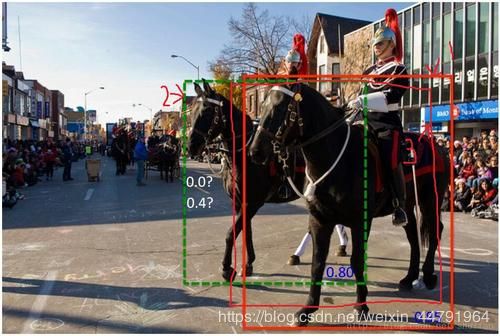睿智的目标检测31——非极大抑制NMS与Soft-NMS
睿智的目标检测31——非极大抑制NMS与Soft-NMS
- 学习前言
- 什么是非极大抑制NMS
- 1、非极大抑制NMS的实现过程
- 2、柔性非极大抑制Soft-NMS的实现过程
学习前言
非极大抑制是目标检测中非常非常非常非常非常重要的一部分,了解一下原理,撕一下代码是必要的!
![]()
什么是非极大抑制NMS
非极大抑制的概念只需要看这两幅图就知道了:
下图是经过非极大抑制的。
下图是未经过非极大抑制的。
可以很明显的看出来,未经过非极大抑制的图片有许多重复的框,这些框都指向了同一个物体!
可以用一句话概括非极大抑制的功能就是:
筛选出一定区域内属于同一种类得分最大的框。
1、非极大抑制NMS的实现过程
本博文实现的是多分类的非极大抑制,该非极大抑制使用在我的pytorch-yolov3例子中:
输入shape为[ batch_size, all_anchors, 5+num_classes ]
第一个维度是图片的数量。
第二个维度是所有的预测框。
第三个维度是所有的预测框的预测结果。
非极大抑制的执行过程如下所示:
1、对所有图片进行循环。
2、找出该图片中得分大于门限函数的框。在进行重合框筛选前就进行得分的筛选可以大幅度减少框的数量。
3、判断第2步中获得的框的种类与得分。取出预测结果中框的位置与之进行堆叠。此时最后一维度里面的内容由5+num_classes变成了4+1+2,四个参数代表框的位置,一个参数代表预测框是否包含物体,两个参数分别代表种类的置信度与种类。
4、对种类进行循环,非极大抑制的作用是筛选出一定区域内属于同一种类得分最大的框,对种类进行循环可以帮助我们对每一个类分别进行非极大抑制。
5、根据得分对该种类进行从大到小排序。
6、每次取出得分最大的框,计算其与其它所有预测框的重合程度,重合程度过大的则剔除。
实现代码如下:
import numpy as np
def non_max_suppression(boxes, num_classes, conf_thres=0.5, nms_thres=0.4):
bs = np.shape(boxes)[0]
# 将框转换成左上角右下角的形式
shape_boxes = np.zeros_like(boxes[:,:,:4])
shape_boxes[:,:,0] = boxes[:,:,0] - boxes[:,:,2]/2
shape_boxes[:,:,1] = boxes[:,:,1] - boxes[:,:,3]/2
shape_boxes[:,:,2] = boxes[:,:,0] + boxes[:,:,2]/2
shape_boxes[:,:,3] = boxes[:,:,1] + boxes[:,:,3]/2
boxes[:,:,:4] = shape_boxes
output = []
# 1、对所有图片进行循环。
for i in range(bs):
prediction = boxes[i]
# 2、找出该图片中得分大于门限函数的框。在进行重合框筛选前就进行得分的筛选可以大幅度减少框的数量。
mask = prediction[:,4] >= conf_thres
prediction = prediction[mask]
if not np.shape(prediction)[0]:
continue
# 3、判断第2步中获得的框的种类与得分。
# 取出预测结果中框的位置与之进行堆叠。
# 此时最后一维度里面的内容由5+num_classes变成了4+1+2,
# 四个参数代表框的位置,一个参数代表预测框是否包含物体,两个参数分别代表种类的置信度与种类。
class_conf = np.expand_dims(np.max(prediction[:, 5:5 + num_classes], 1),-1)
class_pred = np.expand_dims(np.argmax(prediction[:, 5:5 + num_classes], 1),-1)
detections = np.concatenate((prediction[:, :5], class_conf, class_pred), 1)
unique_class = np.unique(detections[:,-1])
if len(unique_class) == 0:
continue
best_box = []
# 4、对种类进行循环,
# 非极大抑制的作用是筛选出一定区域内属于同一种类得分最大的框,
# 对种类进行循环可以帮助我们对每一个类分别进行非极大抑制。
for c in unique_class:
cls_mask = detections[:,-1] == c
detection = detections[cls_mask]
scores = detection[:,4]
# 5、根据得分对该种类进行从大到小排序。
arg_sort = np.argsort(scores)[::-1]
detection = detection[arg_sort]
print(detection)
while np.shape(detection)[0]>0:
# 6、每次取出得分最大的框,计算其与其它所有预测框的重合程度,重合程度过大的则剔除。
best_box.append(detection[0])
if len(detection) == 1:
break
ious = iou(best_box[-1],detection[1:])
detection = detection[1:][ious<nms_thres]
output.append(best_box)
return np.array(output)
def iou(b1,b2):
b1_x1, b1_y1, b1_x2, b1_y2 = b1[0], b1[1], b1[2], b1[3]
b2_x1, b2_y1, b2_x2, b2_y2 = b2[:, 0], b2[:, 1], b2[:, 2], b2[:, 3]
inter_rect_x1 = np.maximum(b1_x1, b2_x1)
inter_rect_y1 = np.maximum(b1_y1, b2_y1)
inter_rect_x2 = np.minimum(b1_x2, b2_x2)
inter_rect_y2 = np.minimum(b1_y2, b2_y2)
inter_area = np.maximum(inter_rect_x2 - inter_rect_x1, 0) * \
np.maximum(inter_rect_y2 - inter_rect_y1, 0)
area_b1 = (b1_x2-b1_x1)*(b1_y2-b1_y1)
area_b2 = (b2_x2-b2_x1)*(b2_y2-b2_y1)
iou = inter_area/np.maximum((area_b1+area_b2-inter_area),1e-6)
return iou
2、柔性非极大抑制Soft-NMS的实现过程
柔性非极大抑制和普通的非极大抑制相差不大,只差了几行代码。
柔性非极大抑制认为不应该直接只通过重合程度进行筛选,如图所示,很明显图片中存在两匹马,但是此时两匹马的重合程度较高,此时我们如果使用普通nms,后面那匹得分比较低的马会直接被剔除。
Soft-NMS认为在进行非极大抑制的时候要同时考虑得分和重合程度。

我们直接看NMS和Soft-NMS的代码差别:
如下为NMS:
while np.shape(detection)[0]>0:
# 6、每次取出得分最大的框,计算其与其它所有预测框的重合程度,重合程度过大的则剔除。
best_box.append(detection[0])
if len(detection) == 1:
break
ious = iou(best_box[-1],detection[1:])
detection = detection[1:][ious<nms_thres]
如下为Soft-NMS:
while np.shape(detection)[0]>0:
best_box.append(detection[0])
if len(detection) == 1:
break
ious = iou(best_box[-1],detection[1:])
detection[1:,4] = np.exp(-(ious * ious) / sigma)*detection[1:,4]
detection = detection[1:]
scores = detection[:,4]
arg_sort = np.argsort(scores)[::-1]
detection = detection[arg_sort]
我们可以看到,对于NMS而言,其直接将 与得分最大的框 重合程度较高的其它预测剔除。而Soft-NMS则以一个权重的形式,将获得的IOU取高斯指数后乘上原得分,之后重新排序。继续循环。
实现代码如下:
import numpy as np
def non_max_suppression(boxes, num_classes, conf_thres=0.5, sigma=0.5, nms_thres=0.4):
bs = np.shape(boxes)[0]
# 将框转换成左上角右下角的形式
shape_boxes = np.zeros_like(boxes[:,:,:4])
shape_boxes[:,:,0] = boxes[:,:,0] - boxes[:,:,2]/2
shape_boxes[:,:,1] = boxes[:,:,1] - boxes[:,:,3]/2
shape_boxes[:,:,2] = boxes[:,:,0] + boxes[:,:,2]/2
shape_boxes[:,:,3] = boxes[:,:,1] + boxes[:,:,3]/2
boxes[:,:,:4] = shape_boxes
output = []
# 1、对所有图片进行循环。
for i in range(bs):
prediction = boxes[i]
# 2、找出该图片中得分大于门限函数的框。在进行重合框筛选前就进行得分的筛选可以大幅度减少框的数量。
mask = prediction[:,4] >= conf_thres
prediction = prediction[mask]
if not np.shape(prediction)[0]:
continue
# 3、判断第2步中获得的框的种类与得分。
# 取出预测结果中框的位置与之进行堆叠。
# 此时最后一维度里面的内容由5+num_classes变成了4+1+2,
# 四个参数代表框的位置,一个参数代表预测框是否包含物体,两个参数分别代表种类的置信度与种类。
class_conf = np.expand_dims(np.max(prediction[:, 5:5 + num_classes], 1),-1)
class_pred = np.expand_dims(np.argmax(prediction[:, 5:5 + num_classes], 1),-1)
detections = np.concatenate((prediction[:, :5], class_conf, class_pred), 1)
unique_class = np.unique(detections[:,-1])
if len(unique_class) == 0:
continue
best_box = []
# 4、对种类进行循环,
# 非极大抑制的作用是筛选出一定区域内属于同一种类得分最大的框,
# 对种类进行循环可以帮助我们对每一个类分别进行非极大抑制。
for c in unique_class:
cls_mask = detections[:,-1] == c
detection = detections[cls_mask]
scores = detection[:,4]
# 5、根据得分对该种类进行从大到小排序。
arg_sort = np.argsort(scores)[::-1]
detection = detection[arg_sort]
print(detection)
while np.shape(detection)[0]>0:
best_box.append(detection[0])
if len(detection) == 1:
break
ious = iou(best_box[-1],detection[1:])
# 将获得的IOU取高斯指数后乘上原得分,之后重新排序
detection[1:,4] = np.exp(-(ious * ious) / sigma)*detection[1:,4]
detection = detection[1:]
scores = detection[:,4]
arg_sort = np.argsort(scores)[::-1]
detection = detection[arg_sort]
output.append(best_box)
return np.array(output)
def iou(b1,b2):
b1_x1, b1_y1, b1_x2, b1_y2 = b1[0], b1[1], b1[2], b1[3]
b2_x1, b2_y1, b2_x2, b2_y2 = b2[:, 0], b2[:, 1], b2[:, 2], b2[:, 3]
inter_rect_x1 = np.maximum(b1_x1, b2_x1)
inter_rect_y1 = np.maximum(b1_y1, b2_y1)
inter_rect_x2 = np.minimum(b1_x2, b2_x2)
inter_rect_y2 = np.minimum(b1_y2, b2_y2)
inter_area = np.maximum(inter_rect_x2 - inter_rect_x1, 0) * \
np.maximum(inter_rect_y2 - inter_rect_y1, 0)
area_b1 = (b1_x2-b1_x1)*(b1_y2-b1_y1)
area_b2 = (b2_x2-b2_x1)*(b2_y2-b2_y1)
iou = inter_area/np.maximum((area_b1+area_b2-inter_area),1e-6)
return iou